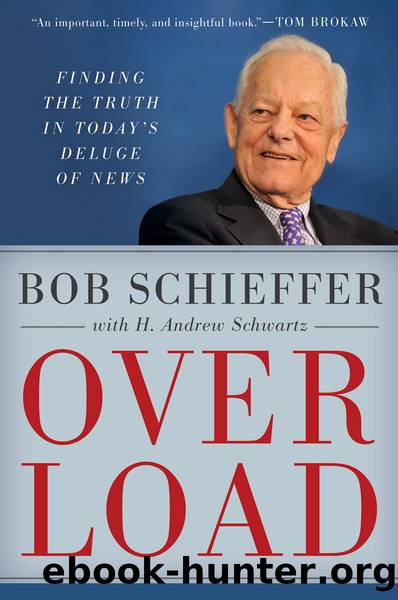Overload by Bob Schieffer & H. Andrew Schwartz

Author:Bob Schieffer & H. Andrew Schwartz
Language: eng
Format: epub
ISBN: 9781538107225
Publisher: Rowman & Littlefield Publishers
Chapter 12
Island in the Stream
CBS News Goes Digital
BY THE TIME THE 2016 CAMPAIGN got underway, all of the network and cable channels were adding more platformsâwebsites, podcasts, and newsletters. As the new administration was taking shape, NBC lured Fox News anchor Megyn Kelly to its stable of correspondents and expanded its overseas reach by buying a stake in a European news-gathering network. But CBS took the most radical step in 2014 when it launched a 24/7 all-news digital outlet aimed at phones and other mobile devices.
It all started in 2012. The CBS Corporation was offered a chance to bid on buying Current TV, the cable channel owned by former Vice President Al Gore and his partners. The CBS team thought it was worth about $125 to $150 million.
It later sold to the Arab kingdom of Qatar for $500 million and became Al-Jazeera America, an ill-fated venture that never caught on and shut down in mid-2016.
At the time, thirty-nine-year-old David Rhodes, the newly installed president of CBS News, had argued against buying the channel.
Instead, he said CBS should adapt a âcable bypass strategy.â CBS had not been involved with cable since 1981 when founder William S. Paley created a channel devoted to the arts and culture. The channel was critically acclaimed but never found an audience and shut down in fourteen months.
Rhodes believed buying back into cable where CBS would be starting out behind CNN, Fox, and MSNBC was just bad strategy.
One analogy he used was that CBS should be like a developing country that had no landline phones. It wouldnât build a landline phone infrastructure; it would go straight to mobile.
He argued CBS should skip cable technology and go straight to streaming, where Netflix and Amazon were already introducing audiences to entertainment programming.
CBS began a search for distribution streaming partners and discussed the idea with several companies, including YouTube. In the end, CBS Interactive Chief Jim Lanzone convinced the Corporation that CBS could create a streaming channel in house. The decision to go forward was not unanimous, but the in-house distribution made the difference and gave CBS the ability to do it at low enough cost to take the risk.
So it was that in November 2014, just two years after Al Goreâs Current Channel was auctioned off to Qatar, CBSN debuted. Al Gore may not have created the Internet as he seemed to suggest in the 2000 campaign, but the sale of his cable channel was clearly the catalyst that started Rhodes and his CBS colleagues thinking about the world of streaming.
When Rhodes called streaming âthe future of newsâ in March 2016, some remained dubious. But by the end of the year, many in the industry conceded that Rhodes and CBSN were on to something.
Audience measurements in 2015 showed that CBSN had attracted 74.2 million streamsâthat is, 74.2 million viewers had tuned in to the channel, either to watch live or to download something from its archive of speeches, statements, or other newsworthy events. But during the election year that had increased to a whopping 207 percent to 227.
Download
This site does not store any files on its server. We only index and link to content provided by other sites. Please contact the content providers to delete copyright contents if any and email us, we'll remove relevant links or contents immediately.
| Africa | Americas |
| Arctic & Antarctica | Asia |
| Australia & Oceania | Europe |
| Middle East | Russia |
| United States | World |
| Ancient Civilizations | Military |
| Historical Study & Educational Resources |
The Dawn of Everything by David Graeber & David Wengrow(1672)
The Bomber Mafia by Malcolm Gladwell(1603)
Facing the Mountain by Daniel James Brown(1524)
Submerged Prehistory by Benjamin Jonathan; & Clive Bonsall & Catriona Pickard & Anders Fischer(1435)
Wandering in Strange Lands by Morgan Jerkins(1389)
Tip Top by Bill James(1375)
Driving While Brown: Sheriff Joe Arpaio Versus the Latino Resistance by Terry Greene Sterling & Jude Joffe-Block(1350)
Red Roulette : An Insider's Story of Wealth, Power, Corruption, and Vengeance in Today's China (9781982156176) by Shum Desmond(1334)
Evil Geniuses: The Unmaking of America: A Recent History by Kurt Andersen(1332)
The Way of Fire and Ice: The Living Tradition of Norse Paganism by Ryan Smith(1317)
American Kompromat by Craig Unger(1288)
It Was All a Lie by Stuart Stevens;(1286)
F*cking History by The Captain(1278)
American Dreams by Unknown(1261)
Treasure Islands: Tax Havens and the Men who Stole the World by Nicholas Shaxson(1238)
Evil Geniuses by Kurt Andersen(1236)
White House Inc. by Dan Alexander(1197)
The First Conspiracy by Brad Meltzer & Josh Mensch(1158)
The Fifteen Biggest Lies about the Economy: And Everything Else the Right Doesn't Want You to Know about Taxes, Jobs, and Corporate America by Joshua Holland(1104)
